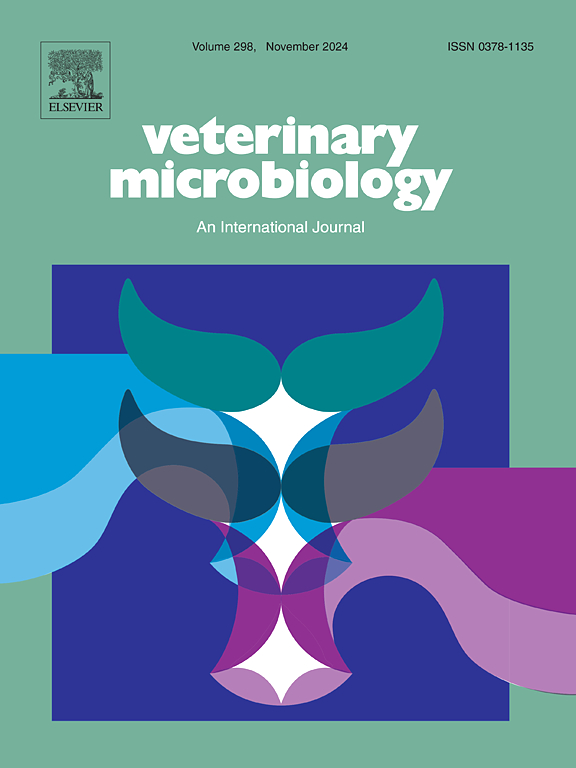树突状细胞靶向截断F蛋白的小环DNA疫苗对鸡新城疫病毒的保护作用增强
IF 2.7
2区 农林科学
Q3 MICROBIOLOGY
引用次数: 0
摘要
由新城疫病毒(NDV)引起的新城疫病(ND)对全球家禽养殖业构成严重威胁,每年造成重大损失。目前ND疫苗在效力和保护时间方面的局限性鼓励了对新型疫苗设计的探索。本研究以延迟裂解沙门氏菌χ11218为载体进行疫苗传递。通过表达与树突状细胞靶向肽(DCpep)融合的截断NDV融合(F)蛋白(tF),可以增强对ND的免疫应答。本研究建立在我们先前对含有全长F蛋白的pYL58质粒的研究基础上。我们成功地用DCpep和缺乏跨膜(TM)结构域和细胞内(CT)结构域的tF蛋白融合取代了pYL58中的F蛋白,得到重组质粒pYL220。沙门氏菌χ11218(pYL220) (S220)通过将DCpep与抗原融合并修改抗原序列增强了免疫应答。与接种亲本株pYL58相比,接种S220可显著提高血清IgG水平,并增加肺和肠黏膜sIgA水平。对于S220组,用40 µg/mL F蛋白刺激培养脾细胞悬液72 h,使用qRT-PCR检测与树突状细胞活化和成熟相关的表面分子,特别是CCL5、CCR7、CD83和CD86。与其他实验组相比,这些分子在S220组显著上调。此外,与其他实验组相比,S220组肺组织中的病毒脱落明显减少,与疫苗组相当。此外,攻毒后雏鸡存活率表明S220具有保护作用,其保护率一直达到50% %。本研究表明,截断抗原与DCpep融合表达不仅具有免疫原性,而且由于其更容易从宿主细胞中释放,增强了对树突状细胞的靶向性,显著增强了免疫效果。这些结果证明,利用沙门氏菌作为载体表达与DCpep融合的tF蛋白是可行的,为研制有效的口服免疫新城疫疫苗奠定了基础。本文章由计算机程序翻译,如有差异,请以英文原文为准。
Enhanced protective efficacy of a dendritic cell-targeting truncated F protein delivery via minicircle DNA vaccine against genotype VII newcastle disease virus in chickens
Newcastle disease (ND), caused by the Newcastle disease virus (NDV), poses a severe threat to global poultry farming, leading to significant losses annually. The limitations of current ND vaccines in terms of efficacy and duration of protection have encouraged the exploration of novel vaccine designs. This study aimed to adopt a delayed-lysis Salmonella strain χ11218 as vaccine delivery vector. By expressing a truncated NDV fusion (F) protein (tF) fused with a dendritic cell-targeting peptide (DCpep), it was used to enhance immune responses against ND. This study builds on our previous work with the pYL58 plasmid which contained the full-length F protein. We successfully replaced the F protein in the pYL58 with a fusion of DCpep and a tF protein lacking a transmembrane (TM) domain and an intracellular (CT), yielding the recombinant plasmid pYL220. Salmonella χ11218(pYL220) (S220) enhanced the immune response by fusing DCpep with the antigen and modifying the antigen sequence. Compared to vaccination with the parental strain pYL58, immunization using S220 resulted in markedly higher levels of serum IgG and increased levels of sIgA in the lung and intestinal mucosa. For the S220 group, qRT-PCR was used to measure the surface molecules associated with dendritic cell activation and maturation, specifically CCL5, CCR7, CD83, and CD86, in the cultured spleen cell suspension stimulated with 40 µg/mL of F protein for 72 h. Compared to other experimental groups, these molecules were significantly upregulated in the S220 group. Additionally, viral shedding in the lung tissue was significantly reduced in the S220 group compared to other experimental groups and was comparable to that of the vaccine group. Furthermore, the post-challenge survival rates of chicks indicated that S220 provided protection, with rates consistently reaching 50 %. This study indicated that the fusion expression of the truncated antigen and DCpep not only provided immunogenicity but also significantly enhanced the immunological effect due to its easier release from host cells and enhanced targeting of dendritic cells. These findings prove that using Salmonella as a vector to express the tF protein fused with DCpep is feasible, laying the foundation for the development of effective and oral immunized NDV vaccines.
求助全文
通过发布文献求助,成功后即可免费获取论文全文。
去求助
来源期刊

Veterinary microbiology
农林科学-兽医学
CiteScore
5.90
自引率
6.10%
发文量
221
审稿时长
52 days
期刊介绍:
Veterinary Microbiology is concerned with microbial (bacterial, fungal, viral) diseases of domesticated vertebrate animals (livestock, companion animals, fur-bearing animals, game, poultry, fish) that supply food, other useful products or companionship. In addition, Microbial diseases of wild animals living in captivity, or as members of the feral fauna will also be considered if the infections are of interest because of their interrelation with humans (zoonoses) and/or domestic animals. Studies of antimicrobial resistance are also included, provided that the results represent a substantial advance in knowledge. Authors are strongly encouraged to read - prior to submission - the Editorials (''Scope or cope'' and ''Scope or cope II'') published previously in the journal. The Editors reserve the right to suggest submission to another journal for those papers which they feel would be more appropriate for consideration by that journal.
Original research papers of high quality and novelty on aspects of control, host response, molecular biology, pathogenesis, prevention, and treatment of microbial diseases of animals are published. Papers dealing primarily with immunology, epidemiology, molecular biology and antiviral or microbial agents will only be considered if they demonstrate a clear impact on a disease. Papers focusing solely on diagnostic techniques (such as another PCR protocol or ELISA) will not be published - focus should be on a microorganism and not on a particular technique. Papers only reporting microbial sequences, transcriptomics data, or proteomics data will not be considered unless the results represent a substantial advance in knowledge.
Drug trial papers will be considered if they have general application or significance. Papers on the identification of microorganisms will also be considered, but detailed taxonomic studies do not fall within the scope of the journal. Case reports will not be published, unless they have general application or contain novel aspects. Papers of geographically limited interest, which repeat what had been established elsewhere will not be considered. The readership of the journal is global.
 求助内容:
求助内容: 应助结果提醒方式:
应助结果提醒方式:


